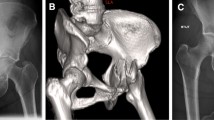Abstract
Purpose
We evaluated the potential advantages of short-segment fixation of certain anterior acetabular fracture patterns through a limited ilioinguinal approach.
Methods
Two patient groups were studied. The first group comprised 22 patients (20 men, two women; average age 36 years) treated using the short-segment fixation protocol through a limited ilioinguinal approach. We modified the use of short pelvic brim plates, spring plates and posterior-column screws as reduction and fixation tools (leaving the distal end of the fracture unfixed) to keep the dissection entirely lateral to the iliac vessels. The second (control) group comprised 31 patients with matched fracture patterns fixed through the standard ilioinguinal approach. All patients were followed up for a minimum of two years. The estimated amount of blood loss (primary outcome measure), operative time, postoperative radiographic assessment of reduction quality and functional score assessment (secondary outcome measures) were compared between groups.
Results
The short-segment-fixation group had significantly less blood loss (p < 0.0001) and shorter operative time (p = 0.002) compared with the control group. However, there were no significant differences in the quality of fracture reduction and functional scores between groups at the final follow-up. No major complications were encountered in either group.
Conclusion
Short-segment fixation through a limited ilioinguinal approach is a safe and effective alternative for treating certain patterns of anterior acetabular fractures. Decreased blood loss and shorter operative time with less soft tissue dissection are the main advantages of this approach.




Similar content being viewed by others
References
Cole JD, Bolhofner BR (1994) Acetabular fracture fixation via a modified Stoppa limited intrapelvic approach. Description of operative technique and preliminary treatment results. Clin Orthop Relat Res 305:112–23
Darmanis S, Lewis A, Mansoor A, Bircher M (2007) Corona mortis: an anatomical study with clinical implications in approaches to the pelvis and acetabulum. Clin Anat 20(4):433–9
Fica G, Cordova M, Guzman L, Schweitzer D (1998) Open reduction and internal fixation of acetabular fractures. Int Orthop 22:348–351
Gaheer RS, Rysavy M, Al Khayarin MM, Kumar K (2009) Femoral artery intimal injury following open reduction of an acetabular fracture. Orthopedics 32(3):212
Jeffcoat DM, Carroll EA, Huber LG, Goldman AT, Miller AN, Lorich DG, Helfet DL (2012) Operative treatment of acetabular fractures in an older population through a limited ilioinguinal Approach. J Orthop Trauma 26:284–289
Judet R, Judet J, Letournel E (1964) Fractures of the acetabulum: classification and surgical approaches for open reduction: preliminary report. J Bone Joint Surg Am 46:1615–1638
Keel MJB, Ecker TM, Cullmann JL, Bergmann M, Bonel HM, Büchler L, Siebenrock KA, Bastian JD (2012) The pararectus approach for anterior intrapelvic management of acetabular fractures: an anatomical study and clinical evaluation. J Bone Joint Surg (Br) 94:405–11
Langford JR, Trokhan S, Strauss E (2008) External iliac artery thrombosis after open reduction of an acetabular fracture: a case report. J Orthop Trauma 22(1):59–62
Letournel E, Judet R (1993) Fractures of the Acetabulum, 2nd edn. Springer, New York
Liu Y, Yang H, Li X, Yang SH, Lin JH (2013) Newly modified Stoppa approach for acetabular fractures. Int Orthop 37(7):1347–53
Mast J, Jakob R, Ganz R (1989) Planning and Reduction Techniques in Fracture Surgery. Springer, Berlin
Matta JM (1986) Operative indications and choice of surgical approach for fractures of the acetabulum. Tech Orthop 1:13–22
Matta JM (1994) Operative treatment of acetabular fractures through the ilioinguinal approach: A 10-year perspective. Clin orthop 305:10–19
Matta JM (1996) Fractures of the acetabulum: accuracy of reduction and clinical results in patients managed operatively within three weeks of the injury. J Bone Joint Surg Am 78:1632–1645
Pocock SJ (1976) The combination of randomized and historical controls in clinical trials. J Chron Dis 29:175–188
Qureshi AA, Archdeacon MT, Jenkins MA, Infante A, DiPasquale T, Bolhofner BR (2004) Infrapectineal plating for acetabular fractures: a technical adjunct to internal fixation. J Orthop Trauma 18(3):175–8
Ruchholtz S, Buecking B, Delschen A, Lewan U, Taeger G, Kuehne C, Zettl R (2013) The two-incision, minimally invasive approach in the treatment of acetabular fractures. J Orthop Trauma 27(5):248–55
Sagi HC, Afsari A, Dziadosz D (2010) The anterior intra-pelvic (modified Rives-Stoppa) approach for fixation of acetabular fractures. J Orthop Trauma 24(5):263–70
Sen RK, Tripathy SK, Aggarwal S, Goyal T, Meena DS, Mahapatra S (2012) A safe technique of anterior column lag screw fixation in acetabular fractures. Int Orthop 36(11):2333–2340
Teague DC, Graney DO, Routt ML (1996) Retropubic vascular hazards of the ilioinguinal exposure: a cadaveric and clinical study. J Orthop Trauma 10(3):156–159
Tile M, Helfet D, Kellam J (2003) Fractures of the Pelvis and Acetabulum, 3rd edn. Lippincott Williams & Wilkins, Baltimore
Xiaoxi J, Fang W, Dongmei W, Fan L, Xiaoqin L, Yunlong S, Jie Z, Qiugen W (2013) Superior border of the arcuate line: Three dimension reconstruction and digital measurements of the fixation route for pelvic and acetabular fractures. Int Orthop 37(5):889–97
Author information
Authors and Affiliations
Corresponding author
Rights and permissions
About this article
Cite this article
Abo-Elsoud, M., Radwan, Y.A., Gobba, M. et al. Short-segment fixation through a limited ilioinguinal approach for treating anterior acetabular fractures: a historical-control study. International Orthopaedics (SICOT) 38, 1469–1475 (2014). https://doi.org/10.1007/s00264-014-2354-6
Received:
Accepted:
Published:
Issue Date:
DOI: https://doi.org/10.1007/s00264-014-2354-6




